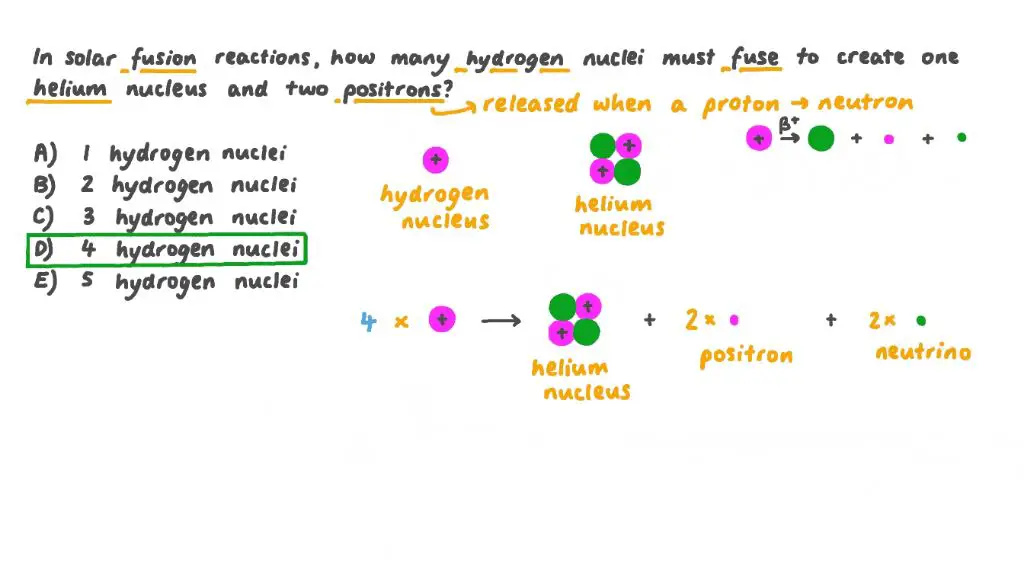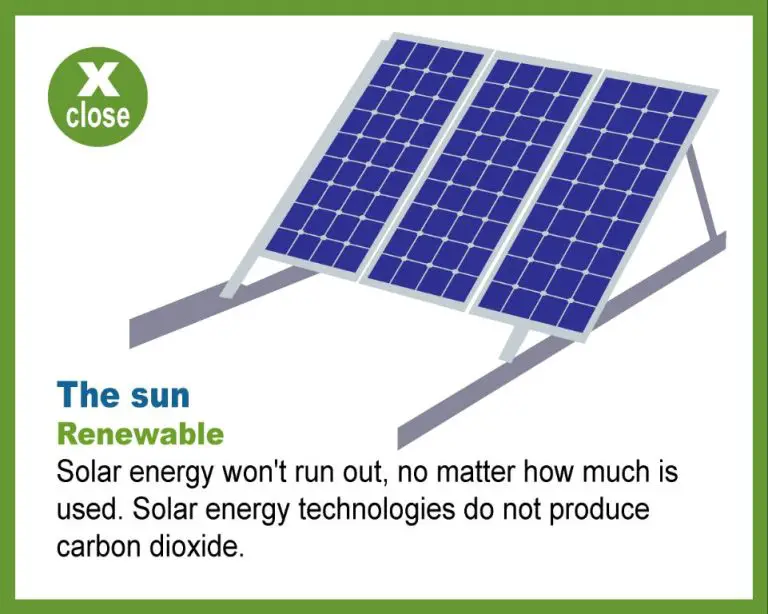What Kind Of Energy Transfer Occurs In The Sun?
The Sun is the star at the center of our solar system and by far the largest object in the solar system. It provides light, heat, and energy to Earth. Without the Sun, life as we know it would not exist on Earth. The Sun is an almost perfect sphere with a diameter of about 1.4 million km and contains 99.8% of the total mass of the solar system. Understanding the energy processes that occur inside the Sun that make life on Earth possible is crucially important.
Nuclear Fusion
Nuclear fusion is the process by which multiple atomic nuclei join together to form a heavier nucleus, releasing enormous amounts of energy in the process. Inside the Sun’s core, nuclear fusion converts hydrogen into helium. This process begins when two protons fuse together to form a deuterium nucleus (hydrogen nucleus with one neutron and one proton). A positron is released when this happens. The deuterium nucleus then fuses with another proton, creating a light helium nucleus (two protons with one neutron) and giving off gamma ray photons in the process. Two light helium nuclei can then fuse, forming a regular helium nucleus (two protons and two neutrons) plus two more protons.
Conditions in the Sun’s Core
The core of the sun is an extremely hot and dense environment that enables nuclear fusion to occur. Temperatures at the center of the sun reach around 15 million degrees Celsius. For comparison, the surface temperature of the sun is about 5,500 degrees Celsius. In addition to the searing heat, the sun’s core is under immense gravitational pressure from the weight of the outer layers. This combination of extreme heat and pressure creates the ideal environment for atoms to overcome their mutual repulsion and fuse together.
Protons and electrons are stripped from hydrogen atoms in the core, creating a soup of nuclei and free-moving particles. With atoms smashed together, protons lack the electrons that would normally keep them apart. The high kinetic energy allows them to overcome their electrostatic repulsion. Nuclear fusion takes place when the nuclei get close enough for the strong nuclear force to bind them together into helium.
This dense plasma where fusion occurs extends out to around a quarter of the way to the sun’s surface. The conditions steadily become less intense, allowing fusion to halt outside of the core. So the extreme temperature and pressure found deep within the sun are essential prerequisites for harnessing the nuclear energy that powers our closest star.
Proton-Proton Chain
At the Sun’s core, the temperature reaches about 15 million degrees Celsius. This vast heat and pressure enables protons (hydrogen nuclei) to fuse and form a helium nucleus. The proton-proton chain reaction is the primary nuclear fusion process inside the Sun that converts hydrogen into helium. Here are the specific steps involved:
- Two protons (hydrogen nuclei) fuse together to form a deuterium nucleus (hydrogen isotope) and a positron. Energy is released.
- The deuterium nucleus fuses with another proton, forming a helium-3 nucleus and releasing gamma ray photons.
- Two helium-3 nuclei fuse, forming a normal helium-4 nucleus and two protons. Energy is released.

At each step, some mass is lost and converted into energy, following Einstein’s famous equation E=mc2. The net result is four protons fused into one helium-4 nucleus. The mass difference is released as energy that travels outward from the core as high-energy gamma rays and particles.
Helium Production
The proton-proton chain reaction results in the fusion of hydrogen nuclei into helium. Inside the core of the Sun, the extreme pressure and temperature enable protons (hydrogen nuclei) moving rapidly to overcome electrical repulsion and fuse together. In the first step of the proton-proton chain, two protons combine to form a deuterium nucleus (with one proton and one neutron). A positron and neutrino are also released in this fusion reaction.
The deuterium nucleus then rapidly fuses with another proton, converting into a light isotope of helium (helium-3) with two protons and one neutron. Two helium-3 nuclei can then fuse, forming a stable helium-4 atom with two protons and two neutrons. At each stage of fusion, a small amount of mass is converted into energy, following Einstein’s famous equation E=mc2. Thus hydrogen is fused into helium within the Sun, releasing energy in the process.
Energy Release
Nuclear fusion releases an enormous amount of energy due to the conversion of mass into energy that occurs during the fusion process. This follows Einstein’s famous equation E=mc2, which states that energy (E) equals mass (m) times the speed of light (c) squared. Even a small amount of mass converted into energy produces a tremendous amount of energy.
In the proton-proton chain reaction, some of the mass of the original hydrogen nuclei (protons) is lost and converted into energy when they fuse together to form a helium nucleus. The helium nucleus has slightly less mass than the protons that formed it. This “lost” mass gets converted to energy in the form of gamma rays and neutrinos.
To put some numbers on it, the fusion of 1 kg of hydrogen into helium converts about 0.7% of the starting mass into energy. But because the speed of light squared is such a huge number, this 0.7% mass difference results in the release of about 6×1014 joules of energy!
So nuclear fusion reactions, like those powering the Sun, release phenomenal amounts of energy from the conversion of mass into energy.
Photon Creation
Inside the core of the sun, the fusion of hydrogen into helium produces gamma rays. These are high-energy photons with extremely short wavelengths. As the gamma rays travel outward from the core, they eventually reach less dense regions of the sun where they can interact with particles and fields. Through these interactions, the high-energy gamma rays get absorbed and reemitted as lower energy photons, mostly in the visible light spectrum. This process conserves energy while converting the gamma rays into the spectrum of sunlight that reaches Earth. So in summary, fusion in the sun’s core produces gamma rays, which get converted into visible light photons during their journey out of the sun’s interior. This process shifts the photons to longer wavelengths but maintains overall energy.
Photon Journey
After fusion reactions produce photons in the core of the Sun, the photons take an extremely long and winding path to reach the surface. The Sun’s interior density decreases from the core outwards, but it still takes photons about 170,000 years on average to travel around 30 million kilometers and escape the Sun!
This is because the conditions inside the Sun are so dense that photons interact with matter constantly via absorption and re-emission. A photon travels only a tiny distance before it is absorbed by an atom or particle, which later emits another photon. This absorbed and re-emitted process repeats quintillions of times for each photon created in the core.
The photons random walk through the solar interior involves so many minuscule steps that the total path length traveled before escaping the surface is astonishing – estimates range from 10 billion to over 30 billion kilometers! The photons’ slow journey through the Sun is important because it gives the radiation time to transfer the tremendous amount of energy generated in the core outward to the surface. This process makes the Sun shine.
Solar Irradiance
The Sun produces a tremendous amount of energy from nuclear fusion reactions in its core. The total solar irradiance (TSI), which is the amount of solar radiative energy reaching Earth, is about 1,361 watts per square meter (W/m2). This is the peak value at the top of the atmosphere when Earth is at its average distance from the Sun. Over the course of a year, the TSI can vary by about 6.9% due to Earth’s elliptical orbit around the Sun. At its furthest point from the Sun, called aphelion, the TSI drops to around 1,322 W/m2. At its closest point, called perihelion, it increases to about 1,404 W/m2. In total, Earth intercepts 174 petawatts (174 million billion watts) of solar radiation.
While solar irradiance may seem variable on a daily or seasonal basis from our perspective on Earth, when measured over long time periods it is remarkably constant. Satellite observations over the past four decades indicate the Sun’s irradiance has increased less than 0.1% per decade. Small variations in the Sun’s output have slightly affected Earth’s climate in the past. But the total solar irradiance provides a nearly constant influx of energy that drives global weather patterns and climate.
Effects on Earth
The Sun’s energy output has profound effects on Earth’s systems. Solar radiation powers Earth’s climate and weather. Energy from the Sun drives atmospheric circulation and the water cycle, leading to wind, rainfall, and ocean currents. Solar heating also fuels convection in the atmosphere and oceans, leading to storms and ocean overturning. Solar radiation is the source of energy for photosynthesis, which supports nearly all life on Earth. Changing solar energy input over geological timescales has contributed to climate transitions between ice ages and warm periods.
On shorter timescales, changes in solar output like sunspots and solar storms interact with Earth’s magnetic field to produce space weather. Solar storms can disrupt power grids, radio communications, and satellite operations. Long-term changes in solar irradiance, like the Maunder Minimum during the Little Ice Age, may have contributed to cooling climates in the past. Monitoring and predicting solar variability remains an active area of research for understanding Earth’s climate.
The Sun also emits solar wind, a stream of charged particles flowing outward that shapes Earth’s magnetosphere. The solar wind compresses the magnetosphere on the day side and stretches it into a long tail on the night side. Charged particles from the solar wind can enter near the poles and cause auroras. Understanding Sun-Earth interactions helps us predict space weather impacts on technology and health.
Overall, Earth owes much of its habitability to stellar fusion reactions taking place at the center of the Sun, 150 million km away. The Sun provides the energy that powers biological and geological processes, maintains liquid water, and enables life on our planet.






